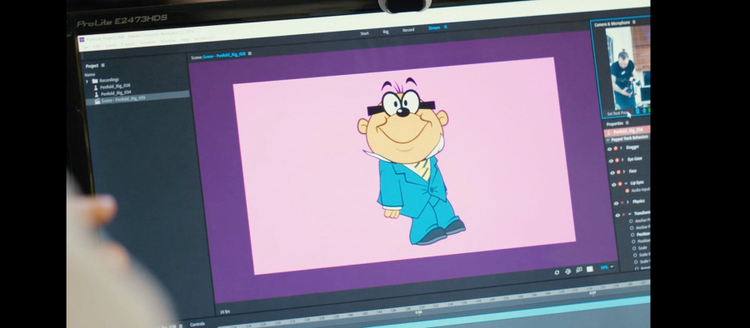Animating the Classic “Danger Mouse” Character Penfold Live on Air

Image courtesy of Kilogramme Animation Studio and CBBC.
Between 1981 and 1992, an entire generation of British school children grew up watching Danger Mouse, a series in which a spy and his hamster sidekick, Penfold, save the world one episode at a time. Much to original viewers’ delight, the Children’s BBC (CBBC) rebooted the classic show in 2015, entertaining a new generation of children with the antics and adventures of its characters.
When Kilogramme Animation Studio in Manchester worked with BBC Children’s Productions to create a live broadcast featuring Penfold interacting with a CBBC presenter and the cheeky puppet Hacker T. Dog in between programs, no one was more excited than character rigger and operator Julia Young. “I knew Penfold from my childhood,” she says. “When I was asked to work on Penfold live it was just absolutely brilliant.”
Julia worked with Kilogramme directors Jon Turner, a 3D animator who worked on the _Postman Pat _series and oversaw the Penfold project; and Claire Grey, a 2D animator who worked on the original _Danger Mouse _series. Together, they collaborated with production to determine how Penfold, voiced by comedian Kevin Eldon, would interact with the presenters live on air. They were then tasked with capturing the spontaneity of the performance while remaining true to the character. To accomplish this, they used Adobe Character Animator in Adobe Creative Cloud.
“Penfold is a deceptively complicated character,” explains Julia. “He’s really sweet and really cute, but there’s a lot of different layering that goes into making him that way.”
Taking the rig from the new Danger Mouse series, Julia broke up the vector images that comprised Penfold’s character so that she could layer them in Adobe Illustrator. Character Animator then read the project in Illustrator to put the character together. From there, she used the various keyboard shortcuts and dragger tools to help bring Penfold to life.
“Penfold has these amazing three hairs on his head. When he moves his head, his hair drags behind him,” says Julia. “It really gets fun when you bring this into Character Animator because you start to add all these little details that you can’t possibly do using just a flat image.”
One of the most challenging features to animate was Penfold’s generous snout. “When he’s turning his head his snout really covers his whole face. To get his mouth moving properly was a challenge,” explains Julia. “But Adobe Character Animator has this process called cycle layers, where I can get his mouth to form ‘ooh’ or ‘ee’ sounds. in one lovely, smooth motion.”
Penfold’s eyes and glasses presented another opportunity for Julia to further expand her knowledge of Character Animator. “His eyes aren’t separate from his glasses; they’re one element,” she says. “When he’s surprised, his glasses go huge; when he’s sad his glasses have to come down with his eyes as well, all the while having to layer this with his big snout and his mouth.”
During the live broadcast, Penfold—whose character was voiced by comedian Kevin Eldon—participated in spontaneous banter with his co-hosts and was able to move and react intuitively with Kevin as his voice and Julia controlling his movements from behind the scenes. At the end of the broadcast, the team was elated with how well it had gone.
“We were able to capture the spontaneity of the performance with Character Animator, which is something you’re always striving for because animation is so planned out that you worry that it will become too scripted,” says Jon.
“But the feedback was really good,” he continues. “It’s really nice to get the best out of software and make something where people will have those ‘wow’ moments.”
Watch the video below: